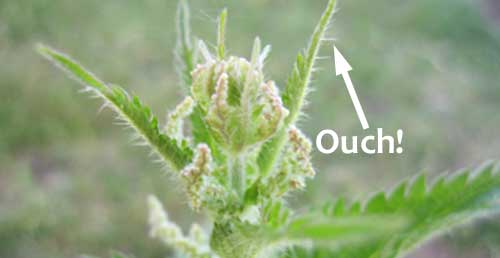Stinging nettle bites, stings and burns, but the plant has so many redeeming and useful qualities it's usually forgiven for being difficult. Nettle is edible, makes an excellent tea and tonic, helps power up the compost pile, and can be used as a green manure. This was our first year growing stinging nettle and we're intrigued enough by the plant's many attributes that we'll be growing it again next year.
According to an entry in Louise Riotte's classic book Carrots Love Tomatoes (Amazon), stinging nettles are covered with syringe-type silica tips that contain formic acid. Once the nettle thorns come in contact with human skin (which is very permeable), the formic acid is released and can cause an allergic reaction similar to the way oils in poison ivy causes a reaction. A bit more researching (on Wikipedia) revealed formic acid is found in the venom of ants and is used as a preservative and antibacterial agent in livestock feed. Wikipedia led to Wikisource which has an entry (fourth up from the bottom, 'Arrow Poison' heading) from an 1889 edition of Popular Science Monthly saying formic acid was also believed to have been used to make poisoned arrows in areas of the Congo. The BBC 'Life' nature series mentions formic acid in the episode on insects. They talk about a beetle that eats the ants, digests the formic acid, then uses it to deter predators by spraying them with the acid. During the episode a mongoose tried to eat the beetle but the beetle sprayed the mongoose with its acid and the spray stopped the mongoose in its tracks.
As far as gardeners are concerned, getting stung by a stinging nettle is definitely not a pleasant experience. It's a combination of a sting, burn, and itch, that also leaves a red rash which lasts a couple of days, so don't handle it if you have an important social engagement that requires short-sleeved shirts. Stinging nettle is also a really, really bad choice for those with small children and pets.

Stinging nettle can become invasive under the right growing conditions. Nettle plants are wind-pollinated and once the seeds mature it's all too easy for them to be dispersed into the garden, so we'd recommend growing nettle in containers. Our nettle plants were grown for use in the compost pile and as a tonic for the tomatoes and artichokes, so we didn't let the plants get too large. We were a bit curious about the seed heads however, and let one plant develop seeds (photo above) although we did cut the seeds off before adding the plants to the compost pile. More about growing stinging nettle from seeds in containers can be found in the Growing Stinging Nettle in Containers post.
Here's a video that shows a stinging nettle eating contest. This particular nettle eating contest is reportedly the original that's held at the Bottle Inn in Dorset, England. Although it doesn't go into details about how to cook stinging nettle, prior to the contest the video shows the nettle being used for filling gnocchi and spanakopita.